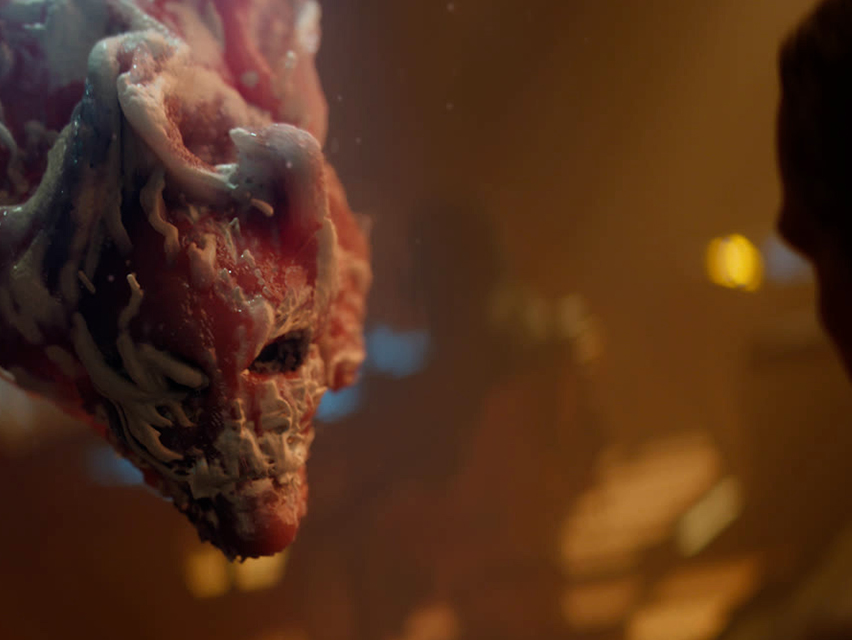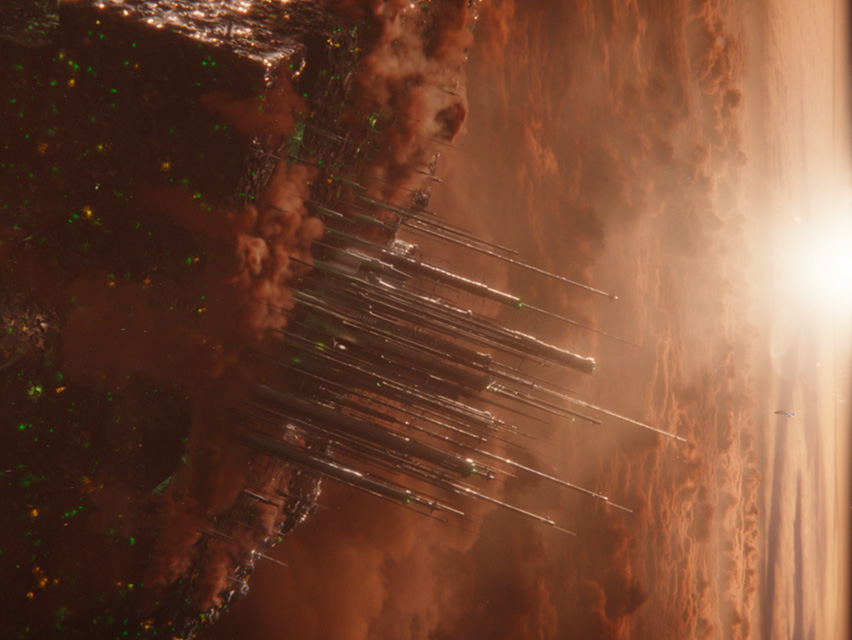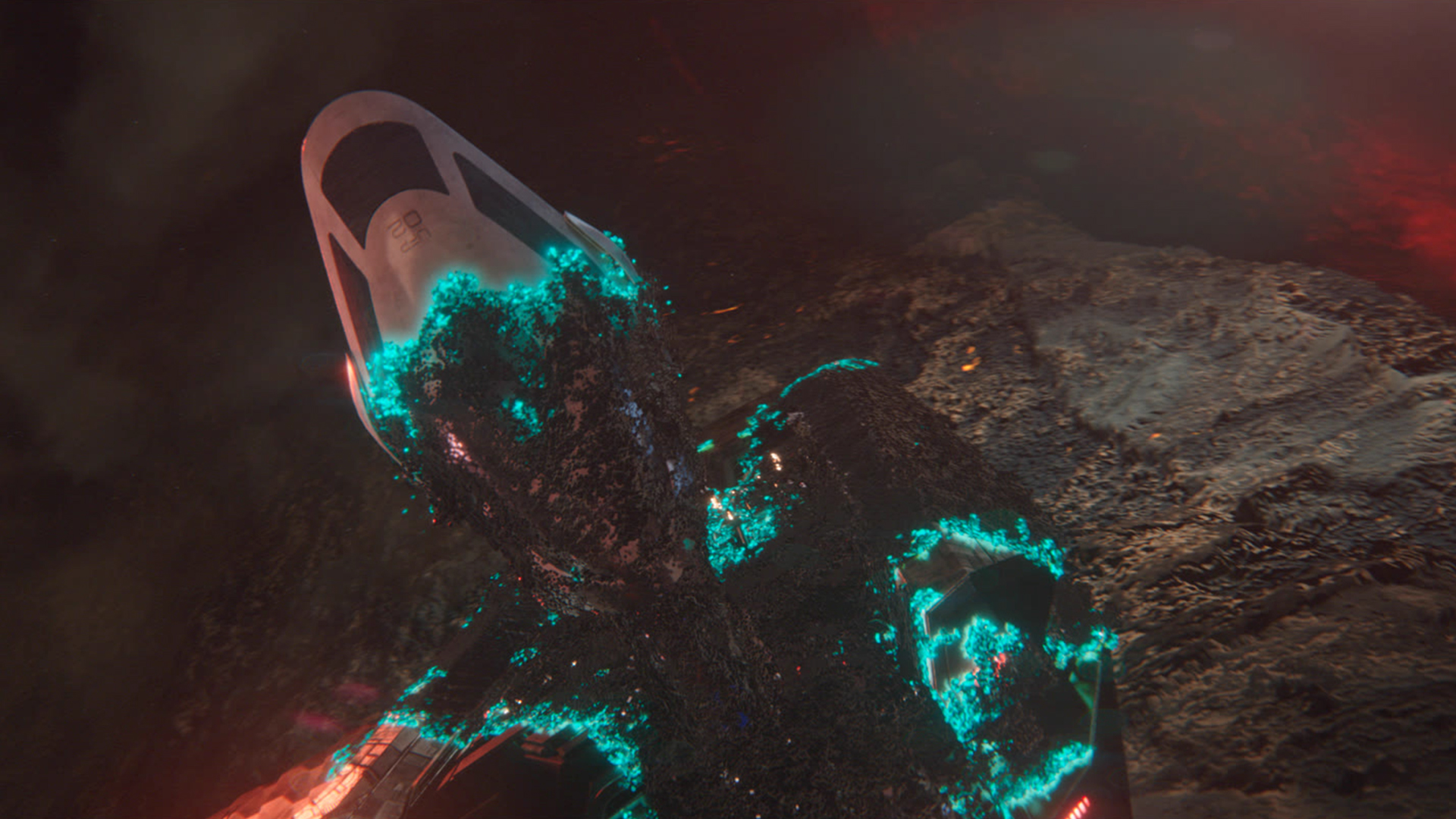Be the first to know — Get Outpost's monthly newsletter for news, tips and job opportunities.

News
Star Trek Picard S3 – Resurrecting the Changeling Menace
3 August 2023
We speak to FX Artist Mike Zhou about his work on the shapeshifting villain of the Star Trek canon
When the team joined Picard’s highly anticipated final season in 2022, they would go on to create some of its most iconic creatures – including the Borg and the Changeling – which would take a collaborative effort between Outpost’s global studios.
The shapeshifting Changelings play a huge role in Star Trek: Picard S3. First appearing on Star Trek: Deep Space Nine, The Changeling can transform from a solid, sometimes humanoid form into a gelatinous goo. In season 3 we also find a version of the Borg Queen, represented in Changeling form, as a floating, liquified head.
Bringing these otherworldly creatures to life would be no simple task, and a big challenge for Outpost’s FX team, in particular. To find out more, we spoke to FX Artist, Mike Zhou, about his process and experience on the show.
What was the process behind the Borg Queen? What did the showrunner want it to look like?
The showrunner saw an artifact of a floating head in a museum, a metal antique, which they liked. They sent a photo and we tried to match the look in 3D. There were so many distinct features, and it was difficult to sculpt, so I used Houdini to procedurally generate a couple of geometries.
It wasn’t until we were finished with the first render that I asked our supervisor what it was for, and he said: “You’re actually working on the representative of the Borg Queen.” They didn’t want to tell us straight away, maybe because they wanted to see what we were going to come up first. It’s cool because we could just go with our gut and make it look interesting.
When I looked up Borg Queen references, I saw that they have electrical circuits on their face which mesh into other parts of the head. These circuits hook around the skull and eye area, so we start adding them to the shape. That's how the creative process began.
You mentioned circuitry on the face, but the final look is also quite organic...
It’s the small tubes going around her, that form the face, mainly in the eye socket area. That's the source of this fluid. The eye section is not fully covered and that's why you see some of the circuits. They bleed into other areas of the face and so we get a more organic look than just an electrical circuit board. So underneath the liquid sim, that’s where we imagined these wires and things.
How did you decide on the look, feel and texture of the asset and how it interacts with the light and colour?
I did the initial lighting shaders. Later, another artist picked it up and redid the lighting – Craig Tonks, the UK Supervisor. We were thinking more like a liquid mesh. A liquid, with blood in it; viscous, but not too like a fluid. You can see through some of it but not everywhere. It’s more water than solid and has unevenly distributed fats that clump together in certain areas. We needed to determine where would it look cool and avoid it looking like bacon or something. We accomplished that through shading and lighting.
With lighting, we just stayed true to the scene and where the light sources are. The shader used a more procedural way to add and alter colour. It's not a direct lighting project where you can take and apply shaders. We use all attributes to determine where those points should be. All those were considered where certain colours should be.
A lot of areas needed to be avoided to show more of the face. We created a lot of masks to make sure they didn't hit those areas, or guide colours away from them, especially the teeth and mouth; they wanted every word spoken to be visible.
The scene where The Changeling is in the chair, then turns into a puddle on the floor, what was your process behind its behaviour?
We discussed how to get this lump to move across the chair and melt, almost like lava, turning it from a solid into a liquid form as it moves. When lava rolls, it takes everything with, because the surface gets hardened when it’s exposed. So that's how this movement of lava can work for this kind of organism.
When the Changeling needs to change form, it must preserve certain areas. So, it turns into a melting effect. The challenging part was how to move it from one point to another and not leave any trails. It’s a fluid sim; it needs to have no friction but at the same time it can’t slide. There were a couple of tricks I used to stop it sliding. I created a lot of force lines around the chair, where I wanted the fluid to go. I just drew curves in 3D space to guide it down.
The trails of goo are based on attributes I gave them. When most of it is attached to the mass, it’ll be affected by friction. When it’s mostly gone, there’s more weight to drag it, and it will lose the friction. That’s how you get a rolling effect of the flesh moving forward. It’s something that I came up with.
In that form some small details come apart from the main body in a rippling motion. What was the process behind that?
It started from the chair scene. I couldn’t get all the details out of the chair, so some particles got disconnected and floated, kind of. We wondered how to remove them from the scene, but the showrunners saw the tests and really liked the leftover, floating details. So, we started introducing more of them.
Interestingly, when the details are disconnected it has its own force. It will move independently and try to join a bigger group. We introduced more of that later. When it’s flowing or going through cracks, they break apart and then try to get back together. It was kind of a happy accident.
In the scenes where the Changeling is liquified, was there any hand sculpting involved, or was it all procedural simulation run through Houdini?
I did have to modify the skull because the model I was given was too much like a human. Some of the features I had to fill with fluid more using the actual mesh. I enlarged the eye sockets, bumped up the cheek area to make it a little scarier and pushed the nose in a little bit more. Eventually, they started changing the model, but I felt like in some areas I needed to make alterations to give me enough space to create a simulation. Since their model topology never changed, all the changes I applied still worked. So, every shot they give new animation, I just apply that same set of nodes and it changed as required.
The client didn’t provide us with a model of the Changeling character’s face. Initially, we used a generic model of a woman and, once we start developing it, the modeler on our team picked it up and added the required features. We had a long discussion about it but were only provided photos of the actor.
How difficult was it to hone in on the look for the Changeling melting?
The client didn’t want everything to melt at once. So, we wanted, say, the nose to come down first, or the eyes roll down, and then the cheek area, rather than everything at the same time. The challenge was melting sections of the face at a time, then making it all blend together.
What was the biggest creative challenge you faced on the project?
I think the scene where the Changeling is melting into the chair gave us the hardest time. It was the end of production and there were a lot of versions. Technically it was quite complex. We had a few iterations at the beginning where the texture wasn’t moving correctly, and the movement didn’t feel right when he transforms. At one point we tried to keep the head in a fixed position as the body drops down, but it was a little bit too creepy.
We went back and forth with how it should be done, and whether we needed to use Maya on top of it to keep it consistent. Instead of using Houdini to finish rendering the shot, I transferred all the textures that I created to Lead 3D Artist Daniel Kumiega, so he could finish the project in Maya.






